Te Hau/Te Hā: Breath and Sounds of Connection
Ariana Tikao
Woven sound
Inside this cave larvae
luminate
fibres writhe
and twist
finding ways to
communicate
wayfinding distances
condense
vibrations seek walls
to bounce
against
strike of bone
breath of gourd
creak of flax
song of seaweed
rattle of seed
thought and reaction
whakapapa
connect1
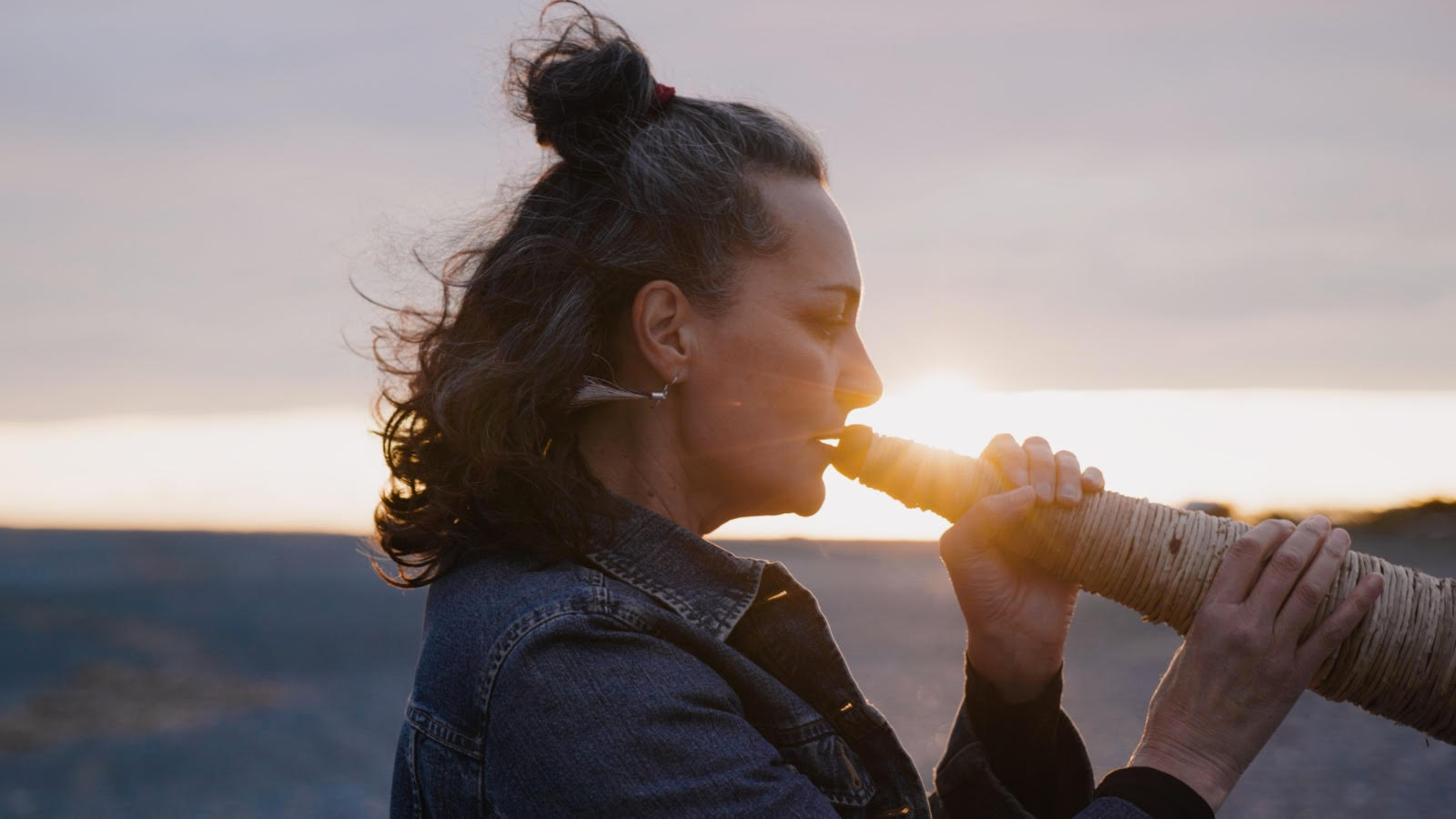
Pictured: Ariana with Pūkāea at sunset, Birdlings Flat, 2020.
Photograph by Augusto Creative Agency
Te hau, te hā. Breath is lifeforce. I breathe, therefore I am in the layer of the living.
Taoka puoro2, the instruments of our tīpuna, were for many years silenced within most whānau and communities around Aotearoa. Many of us did not even know of their existence, let alone know their sounds. Pockets of memory and practices did survive, and these threads were combined into a new whāriki of mātauraka by members of Haumanu, including people such as Richard Nunns, Hirini Melbourne, Brian Flintoff, and Hinewirangi Kohu-Morgan, who spent decades gathering kōrero and reviving the arts of taoka puoro. I feel very fortunate to be in the second wave of Haumanu members who carry on their legacy. We keep breathing life into these taoka, these singing treasures, that sew connections between realms, times, and spaces.
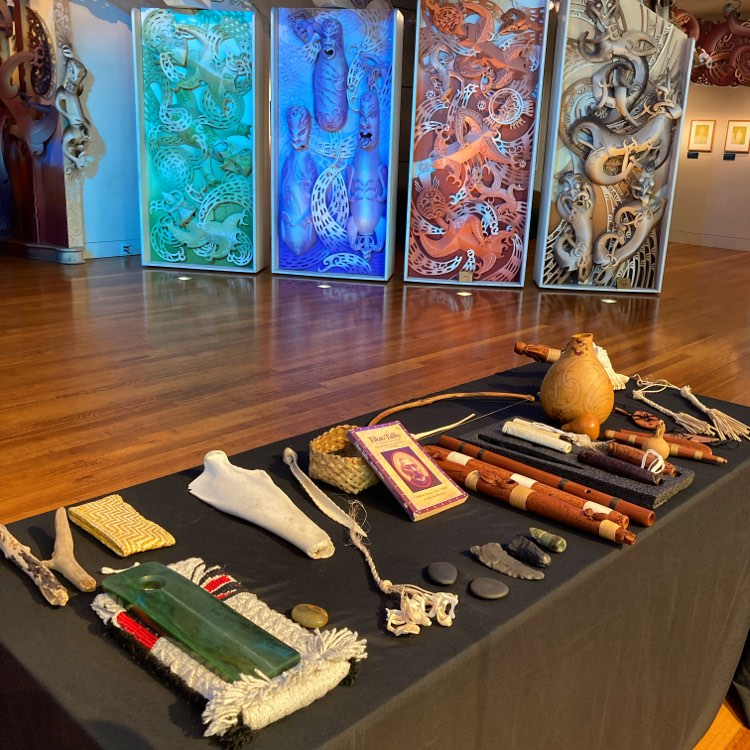
Pictured: My taoka puoro set up for a sound meditation session at Te Papa Tongarewa, 2021. Photograph by Ariana Tikao
Taoka puoro comprise a whole range of instrument types made out of resources from our natural world: wood, stone, bone, gourds, plant fibres, shells, and sometimes a combination of these. Often they emulate sounds heard in our taiao: sounds of birds, insects, water, and wind. They can connect us with non-human entities including atua, the personification of natural elements. In te ao Māori, everything is related through whakapapa, which to me is like a spider’s web of interconnections. This image helps us to visualize how when a vibration happens somewhere along the web, that it is felt in other parts of it. When we play taoka puoro we activate these whakapapa relationships through oro, or sound. Often people describe the sounds that taoka puoro make as “haunting,” which is probably just a way to try and articulate how it makes them feel something deep and “out of the ordinary.” When Māori hear them, they often talk about going on a sonic journey to the forest or moana, or that it brings up memories of other times they have heard them such as whānau events or takihaka at marae.
It helps to let go of ego in the world of taoka puoro, to allow the sounds to emerge in partnership with the taoka. This takes a certain relinquishing of control. Brian Flintoff told me of Hirini Melbourne saying that if we, as humans, control too much, it leaves no room for other entities to bring their magic. As players, we need to learn to not feel bad if the taoka doesn’t make the sound we might have expected from it. Of course, we can learn techniques and practice our playing so that we have a closer relationship with our taoka which might mean that our intentions and the sounds we make are more likely to coalesce. But if we see the playing and oro as more of a partnership, with the taoka having agency, then we can be more accepting of what sounds are produced.
Historically, certain taoka were used within ritual and cultural practices such as pregnancy and birthing, and according to the Ngāi Tūhoe people the pūmotomoto was one such type of instrument.3 Ceremonial uses of taoka puoro are now returning to our whānau and communities, and like layers of whakapapa, there are now another two generations of players and makers of taoka puoro that follow me.
Richard calls them sound icicles
they're a whole insect orchestra to my ear
each fleeting note, hanging off a barely seen thread
like light emanating from glow worms
come in closer, lean on in
Whakaroko ki te pūmotomoto
they were not captives in museums
but were kept alive in the memories of the Children of the Mist
E ai ki a rātou, he taputapu ēnei, hei tohutohu, hei ārahi i te pēpi
he ipu mātauraka, kia kawe i te whakapapa, i te mōteatea, i te oriori
kia mōhio ai te pēpi
ko wai ia4
I’ve recently been supporting the creation of a resource for Kāi Tahu whānau who are bringing new pēpi into the world, called Hākui, named after our Kāi Tahu word for mother.5 This work is based on the research my cousin Kelly Tikao did for her PhD Thesis on Kāi Tahu customary birthing practices, which include the incorporation of oriori and taoka puoro.6 In partnership with a rōpū of Kāi Tahu midwives and others, Kelly and I have been working with whānau to introduce taoka puoro into their whānau through workshops, and we’ve been working with composers from our hapori to write and record oriori—special waiata or chants relating to pregnancy and birthing. The Hākui website includes some older oriori that have once again been given breath, rather than just existing as written text in an archive or in the pages of a book. Oriori often relate to atua, whakapapa, and tīpuna, and are a way to pass on cultural values to future generations, and get them ready for any challenges they may face.
In 2019, I co-curated an exhibition about Māori performing arts called Pūkana, at the National Library of New Zealand, with Paul Diamond and Vicki-Anne Heikell. The core of the exhibition rotated around the concepts of te ihi, te wehi, and te wana that were described by the late Wharehuia Milroy (Ngāi Tūhoe)7. Our interpretation of these concepts, from both his explanation as well as my experience as a performer, was that te ihi is a kind of vibration that wells up from your puku impelling you to act, to get up and haka, or to waiata, or whatever other form of performance the context allows. So “ihi” relates to something internal that the performer uses to strengthen and propel them within a performance. “Ka mau te wehi” is an expression which relates to the power of a performance. “Wehi” can mean ugly, but I think it also relates to a rawness and power that the performer harnesses that connects to atua and wairua. Te wana is also a similar concept to this, and Milroy explains that this can be how people who experience the performance are caught up in a feeling of awe and wonder. When we curated the exhibition, we asked the visitor to try and imagine themselves in the position of the performer. When I am performing, I have these concepts in mind and body. I try to take myself out of my everyday “introverted aquarian” reality, and into something bigger, more connected to those present, to my tīpuna, to our atua, and to our taiao that sustains us. Perhaps that is what liveness means to me in my context of being a contemporary Māori performer and artist.
When thinking of liveness in a music or performance context, what is it that makes it live? Must it be happening in the now with people listening/receiving/communing together in time? Is it contingent on us being in a room breathing together, knowing instinctively the rise and fall of each other’s chests. Te hau, te hā. Some within the room breathe into instruments producing sound. Some breathe in and out, sounding their internal instruments to sing. What is liveness not? Is it still liveness if it is written down and represented as squiggles on a page, amid straight lines, then read by others and played in another moment?
What even makes a performance? I don’t see myself as a natural “performer” and I have now performed over a span of 30 years. In my early days as a musician I used to get anxiety, which could manifest in various ways, such as a dry mouth, or difficulty breathing, which made singing pretty difficult! Growing up, I hated speaking in public or even in front of my class at school. My reports always labelled me as “quiet”. What helps me is to feel that I am not separate from those present. The idea that I am connected to something bigger, a collective, so I am not just me as an individual in these moments. I perform in a variety of settings and, since 2015, have played as a taoka puoro soloist with orchestras around Aotearoa. During one of my first times playing as a soloist for an orchestra, I developed a technique to help me get through what was feeling like a stressful experience: telling myself that those 60 musicians who were on stage behind me were all there to support me, rather than work against me. It helps also to see my offering as something that I can contribute towards creating a common experience. Even the person in row G with a persistent cough, or a small baby who is getting restless and grumbling, this is all part of the live experience, and can help bring us together.
When we engage in our rituals, is that a performance? I began practicing rokoā (Māori healing practices) around ten years ago, but perhaps I was contributing to this realm long ago, before I was even aware of it. The root word of rokoā, is roko (also spelt as rongo), which is an atua of peace, and one of our kupu for senses: to feel, smell, hear, taste, touch, or see. If we tune into our senses, we bring ourselves to a state of awareness and focus. Sometimes it helps to forfeit certain senses so we can concentrate on other senses, in a darkened concert hall for instance.
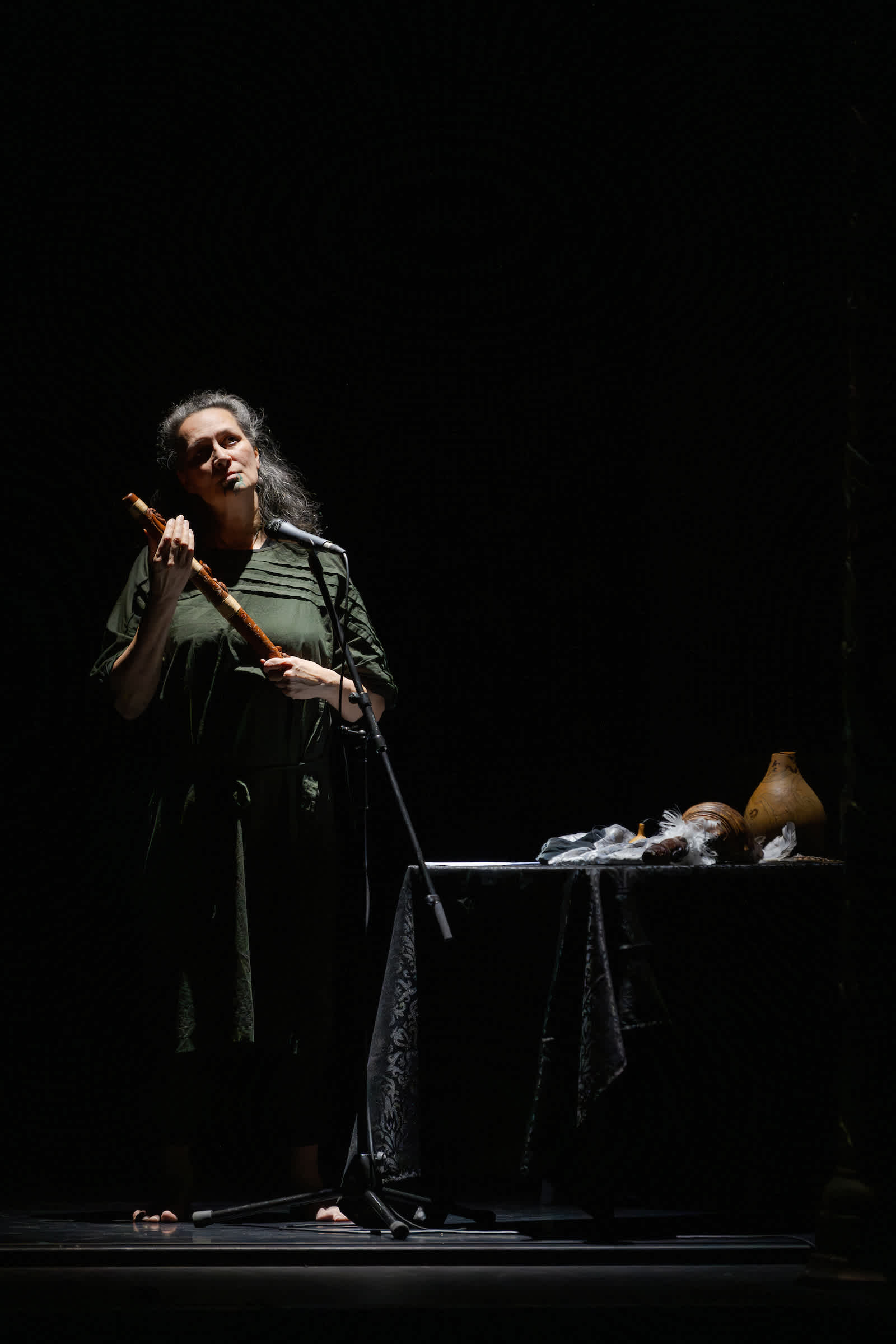
Pictured: Ariana Tikao in Te Ao Mārama by Moss Patterson, Royal New Zealand Ballet, 2023.
Photograph by Stephen A'Court
I recently performed with Shayne Carter and the men of Royal New Zealand Ballet on a piece called Te Ao Mārama choreographed by Moss Patterson. The piece related to one of our most well-known creation stories, the separation of Raki and Papa. The piece started with me playing lower frequencies on my pūtōrino and singing into a darkened theatre, an excerpt of a karakia associated with my whānau, that begins with Te Korekore, the nothingness, then moves into states of Pō, or darkness, and then Te Ao Mārama, the world of light, finishing with Tīhei mauri ora! This represents the sneeze that activated the first breath of the first woman fashioned out of earth, Hineahuone, which touches upon another origin story.
Te Korekore
ka ahu mai kā Pō Takiwā
nō Kā Pō Takiwā
ka ahu mai kā ao katoa
ka puta ki waho
ki tēnei ao
ki Te Ao Mārama
he takata hou
ki tēnei ao
ki Te Ao Mārama
Tīhei mauri ora!8
Whenever I sing this karakia, I try to connect with the essence of the pūrākau. My rokoā teacher Sharlene Maoate-Davis passed on to her tauira a gem of advice, that was passed on to her by her teacher, about “not saying karakia in your boots.” It implies that you have to embody karakia with your full self which means that you enliven the intent, or do not bother. The karakia finishes with a repetition of “Tīhei mauri ora.”
At the end of this moment in the performance, I slowly turned and by then Shayne was creating some gritty electronic sounds on guitar from the other side of the stage, like sparks of new life. In the centre of the stage was a soloist, either Josh or Domani, one of the two men who danced this solo. I loved how each performance was different, and that the soloists developed their solos in partnership with Moss, the choreographer, and also with us and our mahi puoro. We were responding to their movement, and they were riffing their choreography off the sounds we were making. Creatively, you can’t get anything more satisfying than this, and I believe it relates to how mauri is enlivened in performance when we allow space for such “in-the-moment” interactions. Perhaps this helps to answer the question of what is liveness is performance: that there is a presence of the unknown, and an exploration of various potentialities.
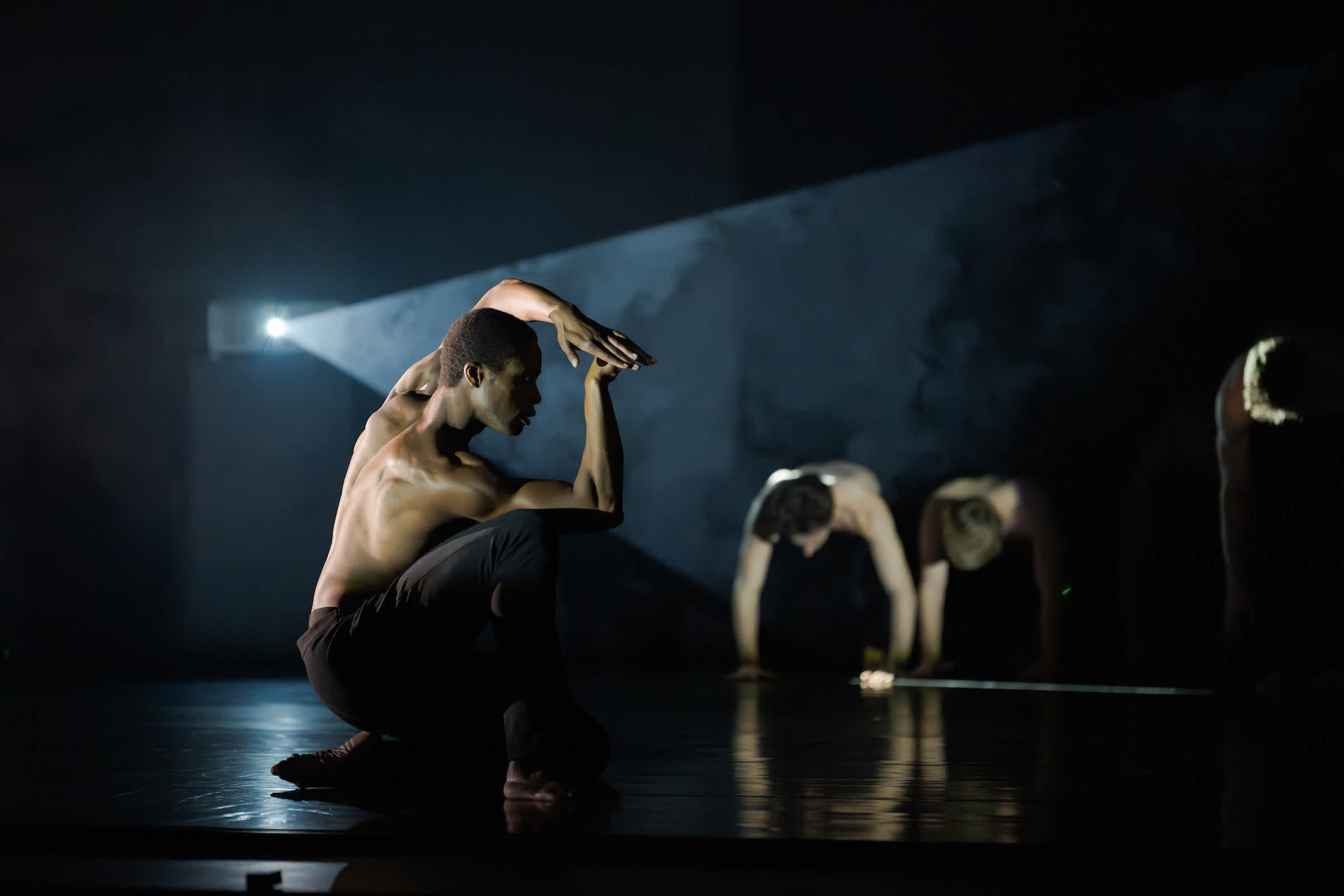
Pictured: Shayne Carter and Damani Campbell Williams in Te Ao Mārama by Moss Patterson, Royal New Zealand Ballet, 2023.
Photograph by Stephen A'Court
He momo ātea. Like the open space out in front of the marae, which is a clearing for debate and interaction. At other times during the piece, the group of dancers were using their steps and breath as the soundtrack for a “silent” haka, and the dance ended with a rousing full-voiced haka from Moss’s and Shayne’s iwi, Ngāti Tūwharetoa, called Haka Wairangi. By this time Shayne and I were making sounds to match the intensity of the haka. It felt to me like we were representing Raki and Papa, in pain from being separated by their tamariki, but also becoming accustomed to a more expansive space created by the transition into Te Ao Mārama.
This cycle of darkness into light is continuously repeated with each night and day, each month as the moon waxes and wanes, and within our own moods and cycles. By tuning in to these natural cycles we can feel more connected to the world around us, and also to each other. By bringing in some of these whakaaro and Te Ao Māori values into the various performance realms within Aotearoa we could create spaces where Māori artists are able to contribute our full selves, and breathe in our own rhythms.
I played recently in the premiere of Dame Gillian Whitehead’s composition Ngā Whetū o Matariki/Stars of Matariki with the Dunedin Symphony Orchestra. During the Q&A session, Dame Gillian received a spontaneous cheer when she said “You can’t colonize taonga puoro,” by which she meant that the taoka puoro player does not read their part off a score, but works more collaboratively with the composer, and indeed with the other players. She also said that a defining characteristic of taoka puoro, and something she keeps in mind when composing for these ancestral treasures, is that “taonga puoro was determined by the breath.” It was such a simple but profound observation. Mā te hā te oro e kawe ai.
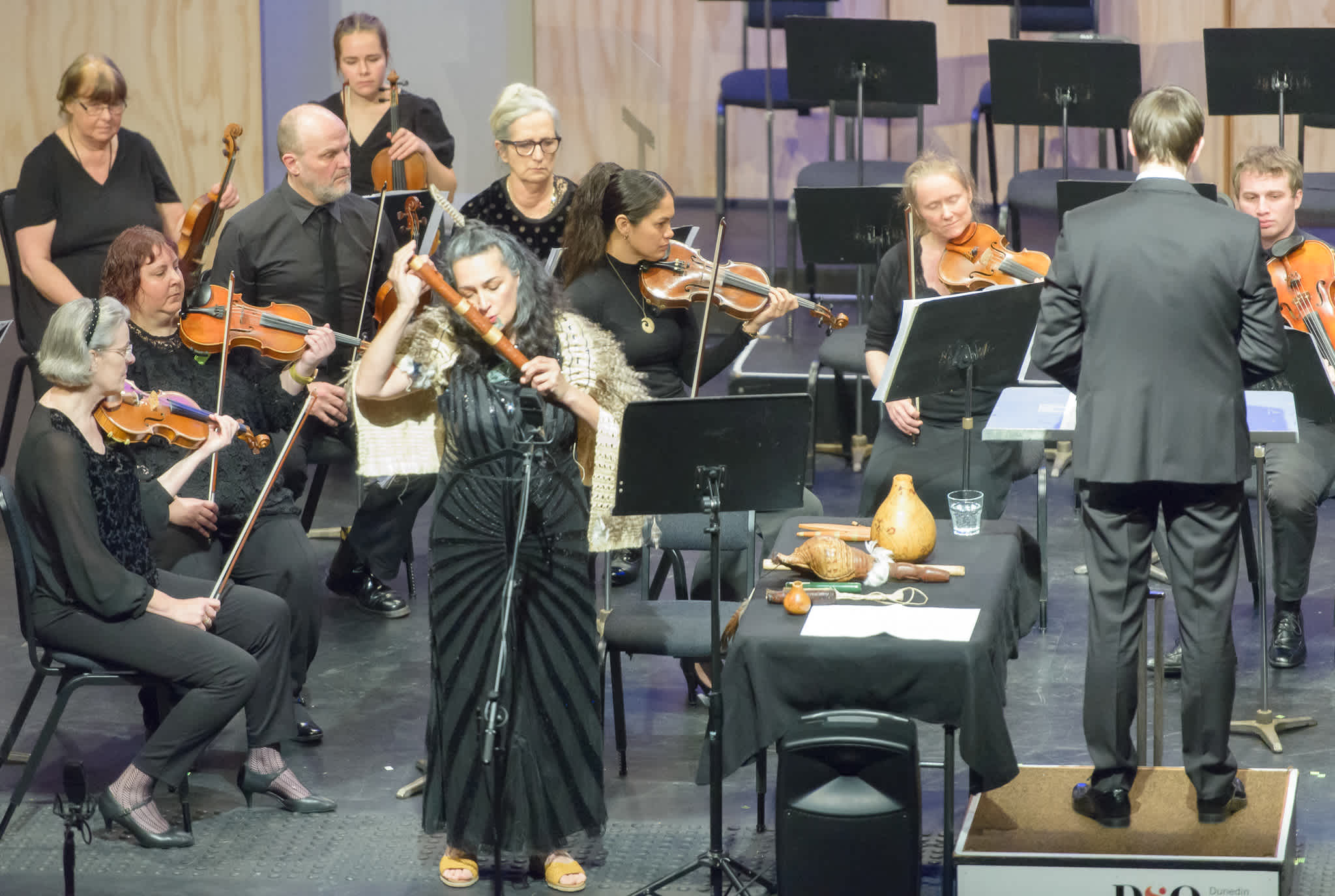
Pictured: Ariana Tikao performing in the Whakanuia Matariki concert in with the Dunedin Symphony Orchestra, July 2023.
Photograph by DSO/Pieter du Plessis
References
Flintoff, Brian. Taonga Pūoro / Singing Treasures: The Musical Instruments of the Māori. Nelson: Craig Potton Publishing, 2004.
Milroy, James Wharehuia. “Te ihi, te wehi, te wana.” In ‘Kia rōnaki : the Māori Performing Arts, edited by Rachael Kaʻai-Mahuta, Tania Kaʻai and John Moorfield. Auckland: Pearson, 2013. Tikao, Kelly Waiana. “Raro timu, raro take: Ngāi Tahu birthing traditions.” Doctoral Thesis, Canterbury University, 2020. https://ir.canterbury.ac.nz/items/cb5f3333-cc67-4790-a734-4ca155ac5024.
Tikao, Teone Taare, and Beattie, H. Tikao Talks: Ka Taoka Tapu O Te Ao Kohatu: Treasures from the Ancient World of the Maori. Auckland: Penguin, 1990.
Notes
1
A poem I wrote for a collaborative exhibition with Anne-Marie Te Whiu, which featured at the Blak Dot Gallery in Melbourne for the Across Oceans (Across Lands) exhibition in 2021.
2
Taoka puoro is the equivalent of taonga puoro (Māori instruments) in the Kāi Tahu dialect.
3
Brian Flintoff, Taonga Pūoro / Singing Treasures: The Musical Instruments of the Māori (Nelson: Craig Potton Publishing, 2004), p.71.
4
Intonation — for Moana Jackson is an unpublished poem I wrote as a tribute to the late Moana Jackson. This is an excerpt of the full poem.
5
Hākui is made up of the kupu “hā” (breath), and “kui” which is usually now an address for an older woman, but originally it was more of a generic word for woman, particularly someone who is a mother. Source: Williams, Herbert. W. A Dictionary of the Maori Language. Seventh Edition. Wellington, Legislation Direct, 1971.
6
Kelly Waiana Tikao, “Raro timu, raro take: Ngāi Tahu birthing traditions” (Doctoral Thesis, Canterbury University, 2020), https://ir.canterbury.ac.nz/items/cb5f3333-cc67-4790-a734-4ca155ac5024.
7
James Wharehuia Milroy, “Te ihi, te wehi, te wana,” in ‘Kia rōnaki : the Māori performing arts, ed. Rachael Kaʻai-Mahuta, Tania Kaʻai and John Moorfield (Pearson: Auckland, 2013).
8
Teone Taare Tikao, and H. Beattie, Tikao Talks: Ka Taoka Tapu O Te Ao Kohatu: Treasures from the Ancient World of the Maori (Auckland: Penguin, 1990).
Ariana Tikao is a musician, composer and writer whose work explores her Kāi Tahu identity, mana wahine, and ancestral kōrero. Ariana is a leading player of taoka puoro and in 2020 was awarded as a New Zealand Arts Laureate. She is the author of Mokorua: My Story of Moko Kauae (AUP, 2022) and Te Rā: The Māori Sail (Christchurch Art Gallery, 2023).
